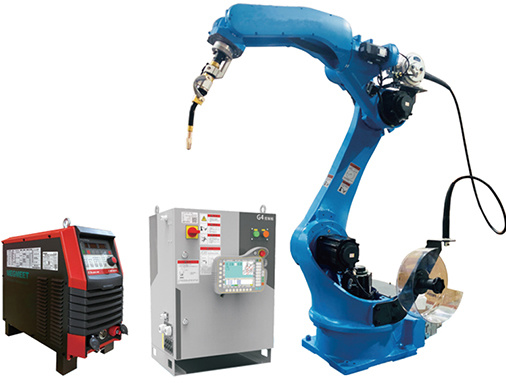News Center
HOW DOES ROBOTIC WELDING WORK?
Robotic welding utilizes industrial robots equipped with welding torches to automate the welding process. Instead of a human welder, a programmed robot precisely and consistently executes welding tasks, significantly improving efficiency, quality, and safety. This article delves into the specifics of robotic welding, exploring its various techniques, advantages, applications, and future outlook.
Welding Processes Used in Robotic Welding
Robotic welding systems can accommodate a range of welding processes, each suited to different materials and applications. These include:
-
Gas Metal Arc Welding (GMAW): Also known as MIG welding, GMAW uses a continuous wire electrode fed into the weld pool, with a shielding gas protecting the weld from atmospheric contamination. It's highly versatile and efficient for various materials.
-
Gas Tungsten Arc Welding (GTAW): Often referred to as TIG welding, GTAW uses a non-consumable tungsten electrode to create the arc. It provides excellent weld quality and is ideal for precision applications, although it's generally slower than GMAW.
-
Shielded Metal Arc Welding (SMAW): More commonly known as stick welding, SMAW uses a consumable electrode coated with flux to protect the weld. While adaptable to diverse situations, it's less efficient and precise than GMAW or GTAW for robotic applications.
-
Laser Beam Welding (LBW): LBW uses a highly focused laser beam to melt and fuse the workpiece materials. It's known for its high speed, precision, and deep penetration capabilities, particularly suitable for automation.
-
Resistance Spot Welding (RSW): This process uses electrical resistance to heat and fuse metal sheets together at specific points. It's commonly used in high-volume automotive applications.
Robotic Welding vs. Manual Welding: A Comparison
| Feature | Robotic Welding | Manual Welding |
|---|---|---|
| Speed | Significantly faster | Much slower |
| Consistency | Highly consistent weld quality | Prone to inconsistencies due to human factors |
| Precision | Extremely precise | Limited by human dexterity and fatigue |
| Accuracy | Higher accuracy and repeatability | Lower accuracy, potential for errors |
| Safety | Reduced risk of welder injury | Higher risk of burns, electric shock, and fumes |
| Cost | Higher initial investment, lower long-term cost | Lower initial investment, higher long-term cost |
| Flexibility | Can be reprogrammed for different tasks | Requires retraining for different welding types |
Types of Robotic Welding Systems
Several factors influence the type of robotic welding system chosen for a particular application:
- Six-axis robots: Offer the greatest flexibility and reach.
- Cartesian robots: Suited for applications requiring precise linear movements.
- SCARA robots: Effective for high-speed pick-and-place operations, also suitable for certain welding tasks.
Real-World Applications of Robotic Welding
Robotic welding is extensively utilized across numerous industries:
- Automotive: High-volume production of car bodies and components.
- Shipbuilding: Welding large and complex structures.
- Aerospace: Precision welding of lightweight materials.
- Construction: Welding of steel structures and components.
- Manufacturing: Welding of various metal parts and assemblies.
Future Trends in Robotic Welding
The future of robotic welding points towards:
- Increased intelligence: Robots with advanced sensors and AI capabilities for adaptive welding.
- Improved collaboration: Human-robot collaborative (HRC) systems for enhanced flexibility and safety.
- Greater integration: Seamless integration with other automation technologies (e.g., material handling, quality control).
- Enhanced process monitoring: Real-time monitoring and feedback to optimize weld quality and efficiency.
Conclusion
Robotic welding represents a significant advancement in welding technology, offering numerous benefits over manual welding. Its efficiency, consistency, precision, and safety features make it an invaluable asset across various industries. As technology progresses, robotic welding will continue to evolve, further enhancing productivity and driving innovation in manufacturing and beyond.














